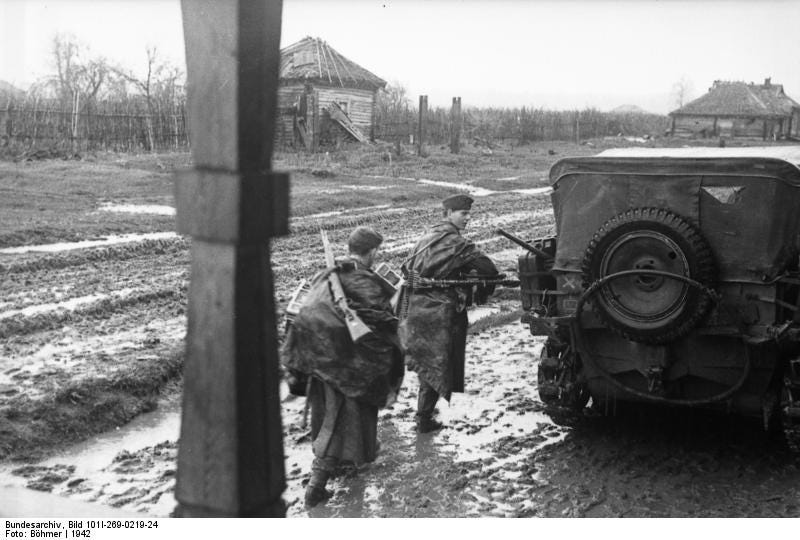Eastern front remains static
16th April 1942: The warming Spring weather still does not allow two vast armies to resume hostilities

Just as the autumn ‘rasputitsa’ had brought delays to the final German thrusts of 1941 so now the spring rasputitsa - time without roads or seasonal quagmire - brought a relative lull in the offensive operations on the Eastern front.
Siegfried Knappe1 had been wounded in early December and now returned to his artillery unit after convalescing in Germany:
I had left my battery in early December at the outermost suburbs of Moscow, but by spring it had been pushed back to a defense line just east of Smolensk. My battery was in log bunkers in a wooded area. Very little was happening on our front. The main thrust of German offensive operations now was being conducted by Army Group South to try to take the rest of the Ukraine and the Caucasus for food and oil.
‘We would exchange artillery salvos with the Russians occasionally just to annoy each other, but there was no sustained combat at this time.’
We would exchange artillery salvos with the Russians occasionally just to annoy each other, but there was no sustained combat at this time. It reminded me of the “sitzkrieg” period in 1939 in the Eifel Mountains. During the winter, Army Group Center was not ready to fight an offensive battle because our men and horses were exhausted and our equipment was worn out, and the Russians apparently did not have the resources to mount another offensive campaign after we had absorbed and blunted their December offensive. They had regrouped, as we had, and were just waiting to see where we would take the offensive.
It was spring and the snow was beginning to melt, ushering in the mud period. Only the Russian farm vehicle called a troika pulled by three little “Panje” (peasant) horses could move on those roads.
Roads had been corduroyed between our battery and the division, so we could get ammunition and supplies to our position, but any major movement by wheeled vehicles was out of the question. Our bunkers had been built the previous fall from fresh-cut logs, and when the thaw started our area of the front became a virtual swamp. The logs of our bunkers even began to sprout new twigs!

The overall situation on the Eastern front was being monitored in Britain2:
MILITARY SITUATION.
Russo-German Campaign.
Leningrad Sector.
The Russians claim, unofficially, to have cut the Leningrad-Dno railway. The operation is believed to have been carried out by strong raiding parties. Otherwise there has been no activity and there is no further information regarding the beleaguered 16th German Army.

‘Thaw conditions, which are unusually severe, continue to limit operations.’
Central Sector.
The German claim to have annihilated four divisions of the Russian 33rd Army refers to operations lasting over some three months. Confirmation is still lacking and the claim is probably exaggerated. It is probable that the Germans have reduced some of the advanced positions which the Russians have established behind the German forward defences. The German claim illustrates the extent of the Russian penetrations and the large number of troops involved.
Ukraine.
Activity has been on a very small scale, due to thaw conditions.
Crimea.
Both sides are preparing for an offensive, and the weather is now suitable for operations.
Summary.
Thaw conditions, which are unusually severe, continue to limit operations. All indications point to mid-May as the earliest date for a German offensive, although a local one in the Crimea might be staged sooner if the Germans can establish air superiority there. The number of German divisions on the Russian Front is 179, including 5 in Finland.

From the Military Situation Report for the week, as reported to the British War Cabinet, see TNA CAB 66/24/6

